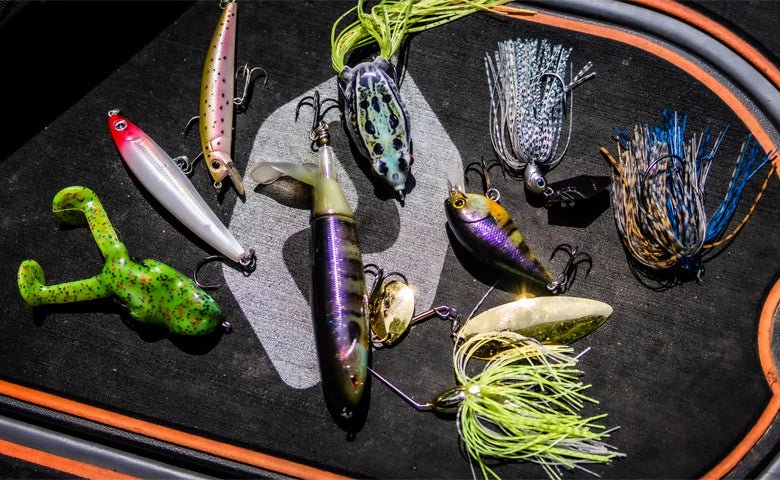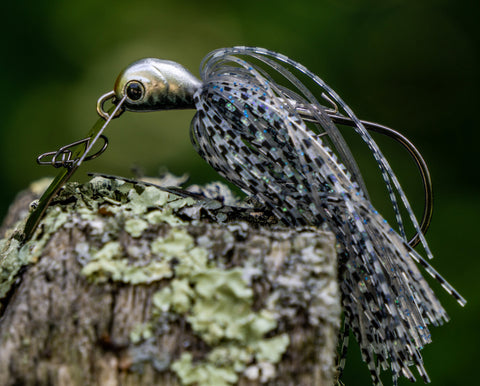Bass Fishing 202: (Lures, Rigs, and Baits) Lures

Now we know all about selecting Rods, Reels, and Line for kayak bass fishing we can move down the line (pun absolutely intended) to what is tied on. You can’t catch fish without a lure, rig, or bait, but what is what? In this 3 part article, we will discuss the various types of lures rigs and baits, when to use them and what they do to catch you those big bass out of a kayak.
What is the difference between a lure, a rig, and a bait? Lures or artificial baits are just that, they are any number of fake bait replications designed to mimic baitfish or other bass forage. A rig is a combination of a hook, weight, float, and/or line that you use to rig an artificial lure or bait a hook. And bait is live or once-living forage for fish, often called live bait, or cut bait, but also including worms and various other bugs. So let’s break those categories down some and get a better understanding of each one. This is part 1 of a 3 part Lures Rigs and Baits series
Lures:
Tournament kayak bass fishermen will argue that this is the only sporting way to fish. Lures up the ante on man vs nature. There are thousands of fishing lures out there, each one represents mans ingenuity in trying to “trick” that big bass into biting. We couldn’t possibly cover each individual presentation out there; however, we will cover the major categories.
Topwater: Nothing is quite as exciting as the topwater bite, huge explosions as the bass breaches to bite a lure sitting on top of the water. It can really get the blood pumping. Lures like frogs, poppers, topwater jerkbaits, walking baits spooks, buzzbaits, prop baits and wake baits are all considered topwater baits.


(Skirmish Baits Pendragon, and Strike King KVD Sexy Frog)
When to fish them: Summertime and any time the water is warm. Early mornings and early evening when the bass are up shallow feeding, at night when a constant sound can help the bass hone in on the bait, any time the bass are schooled up in open water and you see baitfish near the surface it is likely there is a bass underneath them pushing them up against the surface, and any time you see frogs skimming across the water or pads.
How to fish them: The majority of topwater baits are fished with some variation of a twitch twitch pause cadence. Walking baits, frogs, poppers, benefit from a slight twitch of the wrist, then reel the slack, twitch, reel, repeat, find a cadence that works best for you and for the bait you are fishing. Others such as wakebaits, buzzbaits, propbaits, ploppers etc. are fished straight in, relying on props or lips to create a disturbance in the water clueing big bass in that there is something up on top struggling, an easy target.
Jigs: We discussed the top of the water column, let’s move down to the bottom. One of the simplest, and at the same time most complex baits out there. Jigs come in several forms and can be used in many ways. From pitching and flipping to swimming, even finesse and structure jigs. It’s one of the more effective baits out there if you know when and how to use them, many kayak bass fishing tournaments have been won on a jig.



(Strike King Tour Grade Swim Jig, Football Head Jig, and Structure Jig)
When to fish them: Jigs can be fished just about any time of the year, any time of the day. They are more situational dependent than they are weather or time-dependent. They can be changed up according to where the bass are. Any time there are crawfish, a football jig is king, any time there are schooling baitfish a swim jig will catch them if there is thick grass, docks, or cover, a flipping or punching jig is key.
How to fish them: Each type of jig comes with its own technique. Football jigs paired with a craw trailer are bounced off the bottom as you retrieve. A Swim jig with a paddle tail or swimming trailer is pulled in steadily somewhere between the surface and bottom imitating baitfish. Flipping jigs are fished around structure, where a bass might be holding up, they are flipped into position as gently as possible, and worked a few times with the rod tip to encourage a strike, reeling in if there is no action and trying again. Punching jigs are designed to get through that thick vegetation, often you will work them like a flipping jig, only working a short strike zone at a time then reeling in and punching a new hole.
Crankbaits and Jerkbaits: These are far from the same thing, but they are often confused for each other because they are both subsurface hard lures. A crankbait is usually shorter, and wider with a floating action and a big spoon-shaped bill that makes it dive when cranked in. A Jerkbait is longer and thinner, with a smaller bill, some jerkbaits float until reeled, some sink, some are “suspending” Crankbaits are structure and rock kings, bouncing them across the bottom will get those bass all worked up.


(Skirmish Baits M9D, and Strike King KVD Jerkbait)
When to fish them: Crankbaits are primarily fished as reaction baits, fish them any time you are around structure that you can bounce it off. Rocks, roots, logs, docks, or even sand bars that it can “dig” into or bounce off. Jerkbaits are fished often times as cold-water baits but can be used any time of the year if you change your cadence up some. Slower in colder water, faster in warmer water.
How to fish them: Crankbaits are pretty straight forward, reel it in with a pause here and there, however they are not working for you if they are not digging in or bouncing off structure, so choose one that runs to the bottom of whatever depth you are fishing, they come in varied running depths. Jerkbaits require a bit more user input, they are certainly a twitch twitch pause sort of bait, with the retrieval speed being varied based on water temperature to the point that sometimes your pause will last several seconds sometimes you will be tiring yourself out you are moving it so fast, slower for more finicky fish and colder water, faster for warmer water and enthusiastic fish.
Spinnerbaits and Chatterbaits: Spinnerbaits and chatterbaits, both different styles of bladed jigs, a long time secret to triggering that tricky bite. They are both similar in the way they work but different in their approach to doing it. Both baits will “call” fish in from a distance, spinnerbaits do it with flash and a subtle vibration, chatterbaits do it with a hard vibration, and a small amount of flash.


(Z-Man Jackhammer and Rocky Ledge Tackle Speed Demon)
When to fish them: Spinnerbaits are used often for more lethargic fish, in cooler water at the start/end of the year. Any time there is wind pushing into cover spinnerbaits seem to be key. When water starts warming up, the more subtle flash of the chatterbait can be fished the same way. When water is cool, bass cannot see flash quite as acutely as they can when it is warm, so having the bigger blades on the spinnerbait providing more flash will give you that extra visual advantage in those conditions.
How to fish them: Both baits can be fished similarly, a lot of people look at them both as just cast and retrieve baits. But varying your retrieve and letting the bait fall some will give you a few advantages over someone just reeling it straight in, a pause allows the bait to fall, which will let the blades flicker or flash, this drives bass nuts. Varying your retrieve will let you really hone in on how deep in the water column the fish are striking in, once you have a cadence that is working for that day, stick to it and you will be pulling in giants all day.
Swimbaits: Swimbaits are quickly becoming the kayak fishing “big fish” lure of the moment. They come in 2 major styles, soft and hard (some hard swimbaits utilize a heavy-duty rubber, but usually have some sort of frame inside). We will focus on the soft swimbaits in part 2: “Rigging”, so for now let's discuss hard swimbaits. These are made in varying buoyancies that allow you to target different depths. They often feature segmented bodies that allow them to “swim” through the water, many of the favorites are hyper-realistic and match the local forage perfectly. If you are in a kayak bass fishing tournament and need one more big bite, a swimbait just might do it for you.

(Savage Gear 10" Line Through Trout)
When to fish them: Fish them around points, over submerged rocks, or known deep structure. They are often considered clear water lures. The running depth will be the biggest factor on how deep you fish it, some are designed to be fished right at the surface, some are going to allow you to fish as deep as 50ft. So try to match the sink rate to the depth range in which you want to target if you are fishing it over vegetation that is sitting at 10 ft you might want to choose something that is sinking slowly and allows you to just “tickle” the tips of the grass.
How to fish them: Hard swimbaits need to be paired with a rod that can handle them, they often times weigh a fair bit more than most baits in your tackle box, and need a rod that can handle that sort of weight. Toss them out well past your intended target zone as the bigger bait tends to have a pretty significant splash when it hits the water. If you are fishing a sub-surface swimbait, start counting down the time it takes to sink to your desired depth and then go ahead and start your retrieve. They can be fished directly in with a steady retrieve, or you can vary your retrieve with a few flicks and speed bursts mimicking the unpredictable nature of many baitfish. Fishing these large swimbaits can be rewarding, the fish that are going to bite these are often times going to be the bigger fish in the area.
Learning how and when to fish each of these lures and techniques will make you a more experienced kayak bass angler. Whether you are entering kayak bass tournaments or recreationally kayak fishing, knowing when and how to fish with every available weapon in your tackle box will increase your enjoyment on the water.
Stay tuned for ‘Part 2’ in our Lures, Rigs, and Baits series, where we will talk about soft plastics, how to rig them, and when to use them to catch monster bass. Until then, get out there and experiment with these lures and hone your skills so you can show off the biggest bag of fish at your next kayak bass fishing tournament.
No Drama. Just Adventure.


